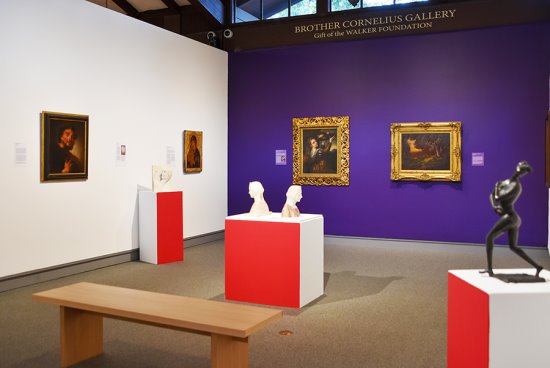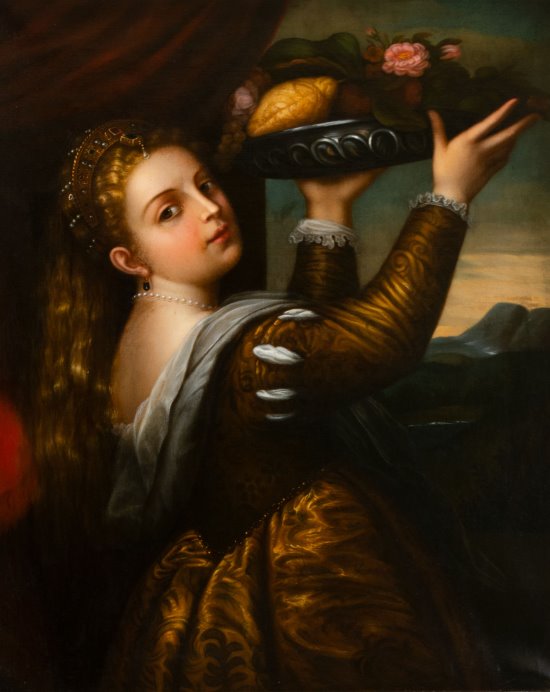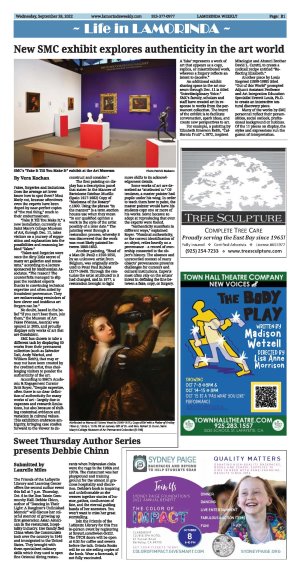| | Published September 28th, 2022
| New SMC exhibit explores authenticity in the art world
| | | By Vera Kochan |  | | SMC's "Fake It Till You Make It" exhibit at the Art Museum Photo Patrick Maisano |
Fakes, forgeries and imitations. Does the average art lover know how to spot them? Most likely not, because oftentimes even the experts have been duped by near-perfect copies of "the real thing," much to their embarrassment.
 "Fake It Till You Make It," a new installation currently at Saint Mary's College Museum of Art, through Dec. 11, takes visitors on a journey of supposition and explanation into the possibilities and reasoning behind "fakes."
"Fake It Till You Make It," a new installation currently at Saint Mary's College Museum of Art, through Dec. 11, takes visitors on a journey of supposition and explanation into the possibilities and reasoning behind "fakes."
 "Fakes and forgeries were once the dirty little secret of many art galleries and museums," according to a lecture sponsored by Smithsonian Associates. "The reason? The counterfeits managed to slip past the resident experts thanks to convincing technical expertise and often aided by fraudulent provenance. They are embarrassing reminders of how clever and insidious art forgers can be."
"Fakes and forgeries were once the dirty little secret of many art galleries and museums," according to a lecture sponsored by Smithsonian Associates. "The reason? The counterfeits managed to slip past the resident experts thanks to convincing technical expertise and often aided by fraudulent provenance. They are embarrassing reminders of how clever and insidious art forgers can be."
 No doubt, based in the belief "if you can't beat them, join them," the Museum of Art Fakes (Vienna, Austria) was opened in 2005, and proudly displays only works of art that are fraudulent.
No doubt, based in the belief "if you can't beat them, join them," the Museum of Art Fakes (Vienna, Austria) was opened in 2005, and proudly displays only works of art that are fraudulent.
 SMC has chosen to take a different tack by displaying 50 works from their permanent collection (such as Salvador Dali, Andy Warhol, and William Keith), that may or may not have been created by the credited artist, thus challenging visitors to ponder the authenticity of the art.
SMC has chosen to take a different tack by displaying 50 works from their permanent collection (such as Salvador Dali, Andy Warhol, and William Keith), that may or may not have been created by the credited artist, thus challenging visitors to ponder the authenticity of the art.
 According to SMC's Academic & Engagement Curator Britt Royer, "Despite expertise, often there is no clear definition of authenticity for many works of art - largely due to expenses and research limitations, but also because of shifting contextual evidence and variation in cultural values. This exhibition embraces ambiguity, bringing case studies forward to the viewer to deconstruct and consider."
According to SMC's Academic & Engagement Curator Britt Royer, "Despite expertise, often there is no clear definition of authenticity for many works of art - largely due to expenses and research limitations, but also because of shifting contextual evidence and variation in cultural values. This exhibition embraces ambiguity, bringing case studies forward to the viewer to deconstruct and consider."
 The first painting on display has a description panel that states: In the Manner of Bartolome Esteban Murillo (Spain 1617-1682) Copy of "Madonna of the Rosary" c.1800. Using the phrase "in the manner" is a term auction houses use when they mean "in our qualified opinion a work in the style of the artist possibly of a later date." The painting went through a restoration process, whereby it was discovered that the work was most likely painted between 1800-1850.
The first painting on display has a description panel that states: In the Manner of Bartolome Esteban Murillo (Spain 1617-1682) Copy of "Madonna of the Rosary" c.1800. Using the phrase "in the manner" is a term auction houses use when they mean "in our qualified opinion a work in the style of the artist possibly of a later date." The painting went through a restoration process, whereby it was discovered that the work was most likely painted between 1800-1850.
 Another painting, "Head of a Man (St .Paul) c.1550-1650, by an unknown artist from Belgium, was originally attributed to Peter Paul Rubens (1577-1640). Through the centuries the artist attributed to it had changed, and in 1977, a restoration brought to light more shifts to its acknowledgement details.
Another painting, "Head of a Man (St .Paul) c.1550-1650, by an unknown artist from Belgium, was originally attributed to Peter Paul Rubens (1577-1640). Through the centuries the artist attributed to it had changed, and in 1977, a restoration brought to light more shifts to its acknowledgement details.
 Some works of art are described as "attributed to." Oftentimes, a master painter had pupils under his wing. In order to teach them how to paint, the master painter would have his students copy one or more of his works. Some became so adept at reproducing that even the experts were fooled.
Some works of art are described as "attributed to." Oftentimes, a master painter had pupils under his wing. In order to teach them how to paint, the master painter would have his students copy one or more of his works. Some became so adept at reproducing that even the experts were fooled.
 "Authenticity manifests in different ways," explained Royer. "Nominal authenticity, or the correct identification of an object, relies heavily on a provenance - a record of ownership connected to the object's history. The absence and unrecorded context of many objects' provenances presents challenges for curators and cultural institutions. Experts must often rely on the artists' intent in defining the line between a fake, copy, or forgery. A 'fake' represents a work of art that appears as a copy, replica, or misattributed work, whereas a forgery reflects an intent to deceive."
"Authenticity manifests in different ways," explained Royer. "Nominal authenticity, or the correct identification of an object, relies heavily on a provenance - a record of ownership connected to the object's history. The absence and unrecorded context of many objects' provenances presents challenges for curators and cultural institutions. Experts must often rely on the artists' intent in defining the line between a fake, copy, or forgery. A 'fake' represents a work of art that appears as a copy, replica, or misattributed work, whereas a forgery reflects an intent to deceive."
 An additional exhibit sharing space in the art museum through Dec. 11 is titled "Interdisciplinary Voice." SMC's faculty, scholars and staff have created art in response to works from the permanent collection. The intent of the exhibit is to facilitate conversation, spark ideas, and create new perspectives to art.
An additional exhibit sharing space in the art museum through Dec. 11 is titled "Interdisciplinary Voice." SMC's faculty, scholars and staff have created art in response to works from the permanent collection. The intent of the exhibit is to facilitate conversation, spark ideas, and create new perspectives to art.
 For example, a painting by Elizabeth Emerson Keith, "California Fruit" c.1872, inspired Mixologist and Alumni Brother David L. Caretti, to create a cocktail recipe entitled "Reflecting Elizabeth."
For example, a painting by Elizabeth Emerson Keith, "California Fruit" c.1872, inspired Mixologist and Alumni Brother David L. Caretti, to create a cocktail recipe entitled "Reflecting Elizabeth."
 Another piece by Louis Siegriest (1899-1989) titled "Out of this World" prompted Adjunct Assistant Professor and Art Integration Education Specialist Everett Louis, Ph.D. to create an interactive textural discovery piece.
Another piece by Louis Siegriest (1899-1989) titled "Out of this World" prompted Adjunct Assistant Professor and Art Integration Education Specialist Everett Louis, Ph.D. to create an interactive textural discovery piece.
 Many of the works by SMC personnel reflect their personalities, social outlook, professional background or hobbies. Of the 11 pieces on display, the styles and expressions run the gamut of interpretation.
Many of the works by SMC personnel reflect their personalities, social outlook, professional background or hobbies. Of the 11 pieces on display, the styles and expressions run the gamut of interpretation. |
 | | Attributed to Marco di Tiziano Vecellio (1545-1611), Copy ofGirl with a Platter of Fruitby Titian (c. 1555) c. 1570, Oil on canvas, Gift of Dr. and Mrs. Robert D. Dunn, Saint Mary's College Museum of Art Permanent Collection [0-106] | | | | | | | | | | | |




